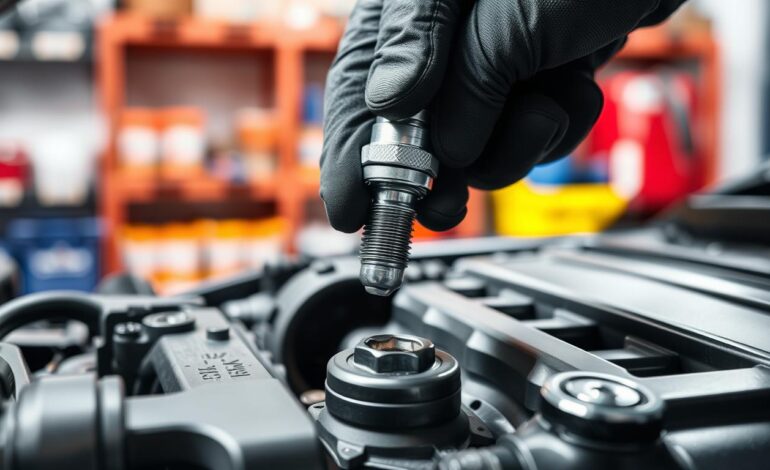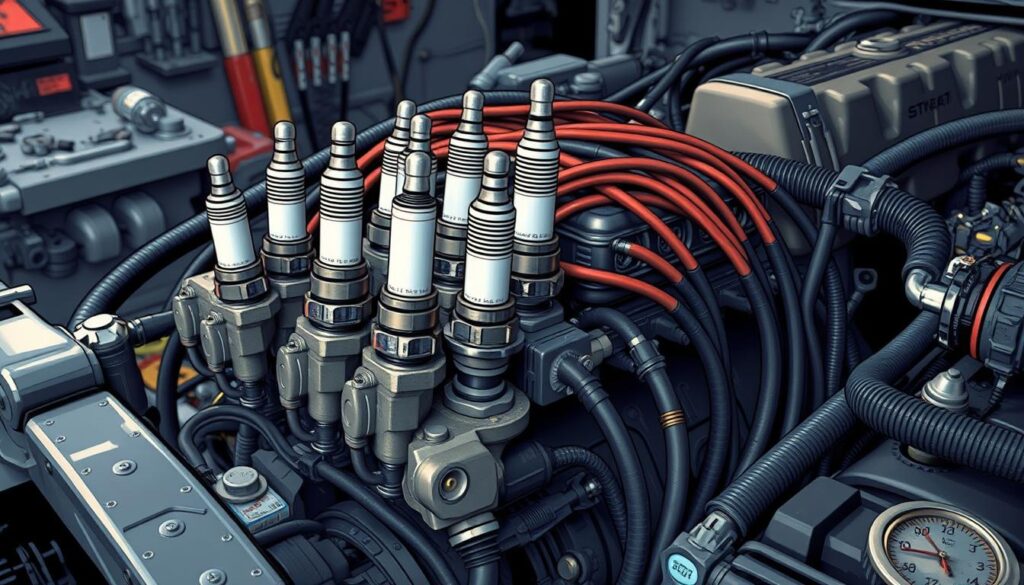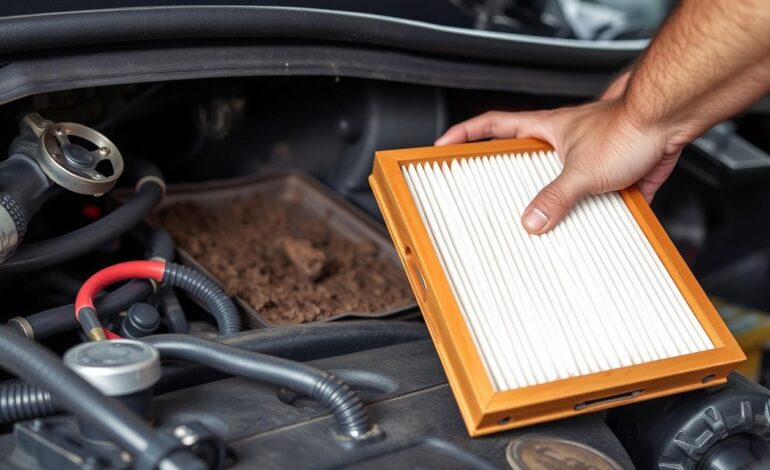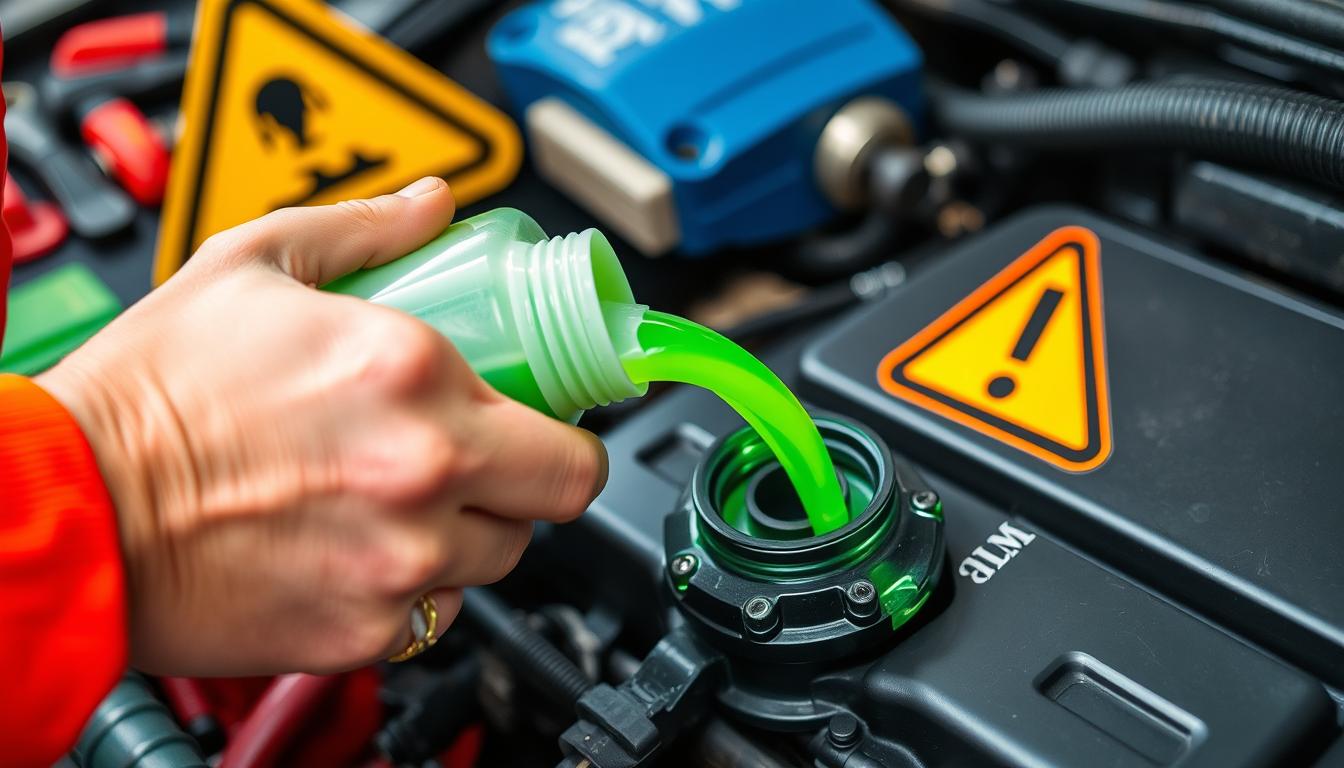
When and How to Change Your Spark Plugs at Home
Spark plugs are key to your car’s ignition system. They ensure your engine runs well and uses fuel efficiently. Replacing spark plugs at home is a must for car care. This guide will show you why spark plugs matter and how to replace them yourself.
This guide will teach you when and how to swap out your spark plugs. Doing this yourself can make your car run better and save you money. With the right tools and a bit of know-how, changing spark plugs is easy.
Key Takeaways
- Spark plugs are essential for engine performance and fuel efficiency
- Spark Plug Replacement can be done at home with the right guidance
- Spark plug DIY methods can save you money and time
- Proper spark plug maintenance is key for your car’s performance
- Regular Spark Plug Replacement boosts fuel efficiency
- Spark plug DIY tasks need the right tools and knowledge
Understanding Spark Plugs and Their Role in Your Engine
Spark plugs are key to your car’s engine. They light the fuel-air mix in the engine’s cylinders. This mix powers your vehicle. Knowing how spark plugs work and their role in engine performance is vital.
The ignition system needs spark plugs to create the spark that ignites the fuel-air mix. If spark plugs fail, you might see misfires, lower fuel efficiency, and engine hesitation. Replacing spark plugs regularly is important for the ignition system’s efficiency.
How Spark Plugs Function
Spark plugs use a high-voltage spark to ignite the fuel-air mix. This happens thousands of times a minute. Over time, spark plugs can wear out, causing engine issues.
Signs of Failing Spark Plugs
Common signs of failing spark plugs include:
- Misfires or rough engine idle
- Reduced fuel efficiency
- Engine hesitation or stumbling
- Difficulty starting the engine
Impact on Engine Performance
Failing spark plugs can hurt your engine’s performance. They can lead to less power, lower fuel efficiency, and more emissions. Replacing spark plugs regularly keeps your engine running well, reduces emissions, and saves money on repairs. It’s important to replace spark plugs as part of your car’s maintenance.
Understanding spark plugs and their role in engine performance helps you maintain your vehicle. Replacing spark plugs as needed ensures your car runs smoothly and efficiently.
Essential Tools and Materials for Spark Plug Replacement
For a successful spark plug DIY, you need the right tools and materials. You’ll need a spark plug socket, a ratchet and extension, and a spark plug gap gauge. These tools make removing old spark plugs and installing new ones easy.
A spark plug socket is essential for any spark plug job. It fits onto the spark plug for a secure grip. This makes it easy to remove and install spark plugs. You’ll also need a ratchet and extension for leverage and reach.
- Spark plug socket
- Ratchet and extension
- Spark plug gap gauge
- New spark plugs
- Torque wrench (optional)
You’ll also need new spark plugs that fit your vehicle. Check your owner’s manual or talk to a mechanic to find the right ones. With the right tools and materials, you’re ready to replace your spark plugs DIY.
Safety Precautions Before Starting the Job
Before you start replacing spark plugs, safety is key. Make sure the engine is cool to avoid burns. A clean, well-ventilated workspace is also important to prevent accidents.
Knowing the safety rules is vital. It helps you stay safe while working on your car’s ignition system. Always take steps to protect yourself and your vehicle.
Engine Temperature Considerations
Always check the engine’s temperature before starting. If it’s hot, wait until it cools down. This ensures a safe and smooth process.
Workspace Requirements
A clean, well-ventilated area is essential. Make sure it’s free from flammable materials and has good lighting. This helps you stay safe and focused.
Personal Protection Equipment
Wear gloves and safety glasses when working on spark plugs. This protects you from risks and makes the job safer.
By following these safety tips, you can replace your spark plugs safely. This ensures your car’s ignition system works well.
Locating Your Vehicle’s Spark Plugs
Understanding your vehicle’s ignition system is key for a DIY spark plug job. The spark plug location varies by vehicle make and model. Start by checking the owner’s manual for a spark plug location guide and engine layout.
Typically, spark plugs are located on the side of the engine or near the cylinder head. Look for ignition coils, as they connect to spark plugs. Some vehicles have spark plugs on the top, while others are on the bottom. Knowing where yours are is vital for a successful DIY project.
Here are some tips to find your vehicle’s spark plugs:
- Check the owner’s manual for a diagram of the engine and spark plug location
- Look for the ignition coils and follow the spark plug wires to the spark plugs
- Consult online resources or repair manuals for your specific vehicle make and model
By following these tips and understanding your vehicle’s ignition system, you can find your spark plugs. Start your DIY project with confidence. Always follow safety precautions and seek professional help if unsure.
| Vehicle Make | Spark Plug Location |
|---|---|
| Toyota | Side of the engine |
| Ford | Near the cylinder head |
| Honda | Top of the engine |
Step-by-Step Spark Plug Replacement Guide
To replace spark plugs, follow a series of steps. This guide will help you do it easily. It’s perfect for both DIY experts and beginners.
Before you start, gather all the tools and materials you need. This will prevent any delays or problems.
Removing the Ignition Coils
The first step is to remove the ignition coils. It’s a simple task but needs care. Handle the coils gently, as they can break easily.
Extracting Old Spark Plugs
After removing the ignition coils, take out the old spark plugs. Use a spark plug socket for this. Be careful not to damage the threads or the spark plug well.
Installing New Spark Plugs
Now, put in the new spark plugs. Make sure to tighten them correctly. This is important for your engine’s performance.
Proper Torque Specifications
The right torque depends on your vehicle’s make and model. Always check your owner’s manual or a repair manual for the correct torque.
By following these steps and using the right tools, you can replace your spark plugs confidently. Always wear safety gear and seek help if you’re unsure about anything.
| Step | Description |
|---|---|
| 1 | Remove the ignition coils |
| 2 | Extract the old spark plugs |
| 3 | Install the new spark plugs |
| 4 | Apply the correct torque specifications |
Common Mistakes to Avoid During Installation
Replacing spark plugs might seem easy, but there are common mistakes that can harm your engine. Knowing these mistakes helps you avoid them and install spark plugs correctly.
Some common errors include over-torquing, using the wrong spark plug type, or not gapping them right. These mistakes can lead to costly repairs. Always follow the manufacturer’s instructions to avoid these problems.
Here are some key mistakes to avoid:
- Using the wrong spark plug type for your vehicle’s ignition system
- Over-torquing the spark plugs, which can damage the engine’s threads
- Failing to gap the spark plugs correctly, which can affect engine performance
By avoiding these mistakes, you can ensure a successful spark plug replacement. This keeps your engine’s ignition system running smoothly. Always follow the manufacturer’s instructions and take precautions to avoid engine damage.

Proper installation is key to keeping your vehicle’s ignition system in top shape. By avoiding common mistakes and following the right steps, you can replace spark plugs with confidence. This ensures your engine runs at its best.
Recommended Spark Plug Brands and Types
Choosing the right spark plug is key for your car’s ignition system. The market offers many options, making it hard to pick the best one. We’ll look at copper, platinum, and iridium spark plugs to help you decide.
Each spark plug type has its own features. Knowing these differences helps you pick the right one for your car. For example, copper plugs are good for older cars, while platinum and iridium are better for newer ones.
Copper Spark Plugs
Copper spark plugs are affordable and conduct heat well. They’re a good fit for cars with lower compression ratios.
Platinum Spark Plugs
Platinum spark plugs last longer and resist wear better. They’re great for cars with higher compression ratios and improve fuel efficiency.
Iridium Spark Plugs
Iridium spark plugs offer the best performance and fuel efficiency. They’re ideal for high-performance cars and last a long time.
In conclusion, picking the right spark plug is vital for your car’s ignition system. By understanding each type’s features, you can choose wisely. This ensures your car runs well and efficiently.
Maintenance Schedule and Replacement Intervals
Regular maintenance is key for your vehicle’s engine to run well. Replacing spark plugs at the right time boosts performance and fuel efficiency. It’s important to use a spark plug DIY guide or get help from a mechanic.
Spark plugs should be replaced every 30,000 to 100,000 miles, depending on your car’s type. But, this can change based on how you drive, your car’s engine, and the spark plug’s material. Always check your car’s manual for the best time to replace spark plugs.
Mileage Guidelines
Most car makers suggest replacing spark plugs at these mileage ranges:
- 30,000 to 50,000 miles for copper spark plugs
- 50,000 to 80,000 miles for platinum spark plugs
- 80,000 to 100,000 miles for iridium spark plugs
Performance Indicators
There are signs that show when it’s time to replace spark plugs. These include:
- Decreased fuel efficiency
- Reduced engine power
- Rough engine idle
- Misfires or engine hesitation
By following these guidelines and watching for performance signs, you can replace spark plugs on time. This keeps your engine running smoothly. Always use a spark plug DIY guide or get help from a mechanic to do the job right and safely.
Troubleshooting After Spark Plug Replacement
After replacing spark plugs, make sure your car’s ignition system works right. If you see problems like misfires or a weak engine, you might need to find the cause. Issues could be with the ignition, fuel, or engine compression.
Some things to check include:
- Spark plug wires and boots for damage or wear
- Fuel filters and fuel injectors for clogs or blockages
- Engine compression to ensure it’s within the recommended range
To fix these problems, use tools like a spark tester or a compression gauge. Also, look at your car’s repair manual for help. If DIY repairs seem too hard, get a professional mechanic. Always be safe when working with your car’s ignition system and replace spark plugs correctly.

By following these tips, you can make sure your car runs well after spark plug replacement. Whether you do it yourself or take it to a mechanic, keeping your car in good shape is key. It helps your car last longer and saves you money on repairs.
| Common Issues | Possible Causes | Troubleshooting Steps |
|---|---|---|
| Misfires | Bad spark plugs, faulty ignition coils, or fuel system problems | Check spark plug wires, fuel filters, and ignition coils |
| Poor Engine Performance | Low compression, clogged fuel injectors, or faulty oxygen sensors | Check engine compression, fuel injectors, and oxygen sensors |
Cost Comparison: DIY vs Professional Service
Replacing spark plugs can be a big deal for many people. They often choose to do it themselves to save money. But, it’s important to look at the costs of DIY versus professional help. This will help you decide what’s best for you.
The price of spark plugs varies based on type and quality. They usually cost between $20 to $100. If you go to a mechanic, the labor can cost between $100 to $300. This depends on the mechanic’s rates and how hard the job is.
Parts Pricing
- Average cost of spark plugs: $20 to $100
- Labor cost for professional replacement: $100 to $300
Labor Savings
Doing it yourself can save a lot on labor costs. This is even more true for newer cars with complex engines. Plus, you’ll learn more about your car’s engine and how to take care of it.
Long-term Benefits
Regular DIY maintenance, like replacing spark plugs, can make your car’s engine last longer. This can save you money on big repairs later. By taking care of your engine, you’ll get better performance, better gas mileage, and less chance of engine problems.
Environmental Impact and Proper Disposal of Old Spark Plugs
When you do a spark plug DIY, think about the environment. Old spark plugs and the ignition system can harm the planet. From mining to disposal, there’s a big impact.
Recycling is key for spark plug disposal. Many makers have programs to recycle old spark plugs. This cuts down on landfill waste and saves resources. Check with your local waste agency for recycling options.
Here are steps for safe disposal:
- Remove hazardous parts, like the ceramic insulator
- Recycle the metal parts, like the electrode and shell
- Dispose of non-recyclable items, like packaging, responsibly
Proper disposal of spark plugs helps the environment. It’s part of sustainable car care. As you work on your project, think about the planet.
Conclusion: Maintaining Your Engine Through Proper Spark Plug Care
Spark plug replacement is key to keeping your engine running well. It affects your vehicle’s performance, efficiency, and lifespan. By following this guide, you can keep your spark plugs in good shape, replace them when needed, and dispose of them responsibly.
Regular DIY maintenance of spark plugs is important for your vehicle’s health. With the right knowledge and tools, you can do this at home. It saves money and makes you feel more connected to your car. Proper spark plug care can also make your engine last longer and run better, giving you a smoother ride for years.





